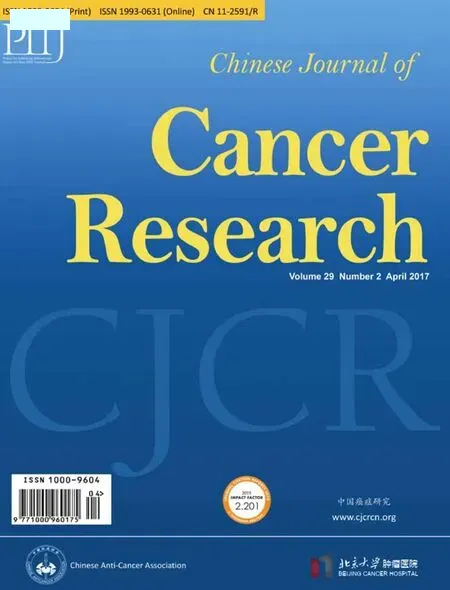Link between dysregulated hypoxia signaling and aberrant methylation in clear cell renal cell carcinoma?
Mayo Clinic, 200 1st street SW, Rochester 55902, Minnesota, USA
Link between dysregulated hypoxia signaling and aberrant methylation in clear cell renal cell carcinoma?
Niraj Shenoy
Mayo Clinic, 200 1st street SW, Rochester 55902, Minnesota, USA
Submitted Mar 28, 2017. Accepted for publication Apr 17, 2017.
View this article at:https://doi.org/10.21147/j.issn.1000-9604.2017.02.10
Dysregulated pseudo-hypoxia (through its effects on cell survival, angiogenesis, metabolism, invasion) and epigenetic dysregulation [through widespread suppression of tumor suppressor genes involved in cell cycle, apoptosis, adhesion, immune evasion, etc. (1)] are considered to be the two central driving pathogenic features in the progression of clear cell Renal Cell Carcinoma (ccRCC) (2,3). These two features also play a significant role in mediating the chemoresistance of radioresistance of ccRCC. The finding of increased DNA methyltransferase 1 (DNMT1) expression in ccRCC by Liet al. (4) provides one mechanistic reason for the previously reported genome wide aberrant methylation seen in ccRCC, leading to the suppression of various important tumor suppressor genes (3,5). Strikingly, this finding may also establish a link between the driver hypoxia inducible factor (HIF) pathway and aberrant methylation seen in von Hippel-Lindau (VHL) defective ccRCC.
BiallelicVHLgene defects are seen in up to 75% of patients with sporadic ccRCC (6). pVHL, product of theVHLtumor suppressor gene, plays a key role in oxygen sensing by targeting HIF-α for ubiquitination and proteasomal degradation. In the absence ofVHLactivity, HIF-α is stabilized, translocates to the nucleus, where it combines with the constitutionally expressed HIF-1β to form heterodimers that bind to hypoxia response elements (HREs) in a wide range of gene promoters, leading to a pseudo-hypoxic state (7,8). Interestingly, HIF-1α has been shown to enhance the expression of DNMT1 and DNMT3b in cardiac fibroblasts. The promoter region of DNMT1 and DNMT3a was seen to have well defined HREs (9). Therefore, it is possible that the finding of enhanced expression of DNMT1 in ccRCC is due to the enhanced HIF-α stabilization seen in ccRCC.
This potential link between dysregulated hypoxia signaling and aberrant methylation in ccRCC needs to be further studied with correlative studies on HIF-1α/HIF-2α expression and DNMT1 expression in ccRCC and with HIF-α knockdown impact on DNMT1 expression and genome wide methylation in ccRCC. Establishing a link between the driver HIF pathway and the genome-wide aberrant methylation in ccRCC could have a significant translational impact, as we could then expect HIF modifying treatment strategies to also have a restorative effect on the aberrant epigenetics in ccRCC.
Acknowledgements
None.
Footnote
Conflicts of Interest: The author has no conflicts of interest to declare.
1.Shenoy N, Vallumsetla N, Zou Y, et al. Role of DNA methylation in renal cell carcinoma. J Hematol Oncol 2015;8:88.
2.Shenoy N, Pagliaro L. Sequential pathogenesis of metastatic VHL mutant clear cell renal cell carcinoma: putting it together with a translational perspective. Ann Oncol 2016;27:1685-95.
3.Cancer Genome Atlas Research Network. Comprehensive molecular characterization of clear cell renal cell carcinoma. Nature 2013;499:43-9.
4.Li M, Wang Y, Song Y, et al. Aberrant DNA methyl-transferase 1 expression in clear cell renal cell carcinoma development and progression. Chin J Cancer Res 2014;26:371-81.
5.Hu CY, Mohtat D, Yu Y, et al. Kidney cancer is characterized by aberrant methylation of tissue-specific enhancers that are prognostic for overall survival. Clin Cancer Res 2014;20:4349-60.
6.van Houwelingen KP, van Dijk BA, Hulsbergen-van de Kaa CA, et al. Prevalence of von Hippel-Lindau gene mutations in sporadic renal cell carcinoma: results from The Netherlands cohort study. BMC cancer 2005;5:57.
7.Gossage L, Eisen T, Maher ER. VHL, the story of a tumour suppressor gene. Nat Rev Cancer 2015;15:55-64.
8.Shenoy N, Shrivastava M, Sukrithan V, et al. The Regulation and Interactions of the Hypoxia Inducible Factor Pathway in Carcinogenesis and Potential Cancer Therapeutic Strategies. J Cancer Ther 2015; 6:511-21.
9.Watson CJ, Collier P, Tea I, et al. Hypoxia-induced epigenetic modifications are associated with cardiac tissue fibrosis and the development of a myofibroblastlike phenotype. Hum Mol Genet 2014;23:2176-88.
Cite this article as:Shenoy N. Link between dysregulated hypoxia signaling and aberrant methylation in clear cell renal cell carcinoma? Chin J Cancer Res 2017;29(2):166-167. doi: 10.21147/j.issn.1000-9604.2017.02.10
10.21147/j.issn.1000-9604.2017.02.10
Niraj Shenoy, MD. Mayo Clinic, 200 1st street SW, Rochester 55902, Minnesota, USA. Email: shenoy.niraj@mayo.edu.
 Chinese Journal of Cancer Research2017年2期
Chinese Journal of Cancer Research2017年2期
- Chinese Journal of Cancer Research的其它文章
- Serum LDH level may predict outcome of chronic lymphocytic leukemia patients with a 17p deletion: a retrospective analysis of prognostic factors in China
- Adjuvant chemotherapy with paclitaxel and cisplatin in lymph node-positive thoracic esophageal squamous cell carcinoma
- Helicobacter pylori antibody responses in association with eradication outcome and recurrence: a population-based intervention trial with 7.3-year follow-up in China
- Apparent diffusion coefficient by diffusion-weighted magnetic resonance imaging as a sole biomarker for staging and prognosis of gastric cancer
- Depth of tumor invasion and tumor-occupied portions of stomach are predictive factors of intra-abdominal metastasis
- Current status and challenges in sentinel node navigation surgery for early gastric cancer
